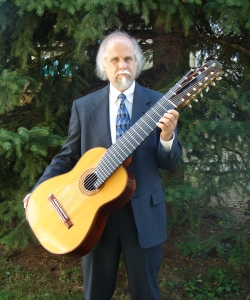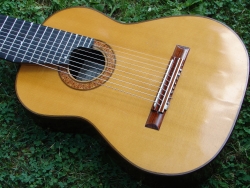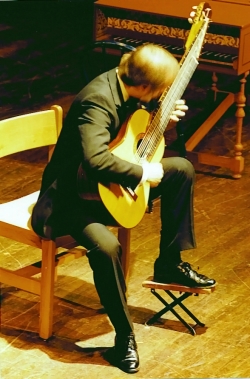|
JAMES
LORUSSO has devoted most of his life to the guitar. For the
past forty years he has worked tirelessly as a performer,
teacher and as a guitar repairman. He has taught at the
Music Conservatory of Westchester for thirty-five years,
Manhattanville College for thirty-two years and Westchester
Community College for fifteen years. His love for
Renaissance and Baroque music, arranging works from the
piano, harpsichord and lute, to the guitar[1], and his studies with Narciso Yepes led
him to play the ten-string guitar in 1978. After placing in
several international competitions, he gave his New York
Debut in CAMI hall in 1984. He still performs on both
traditional 6 and 10 string guitars as a soloist, as well as
performing in a duo with his wife, MaryAnn, who is also a
guitarist.
 For this month's column he offered to
share this poignant account of his longtime friendship with
the luthier, Thomas Humphrey. It is unique for two reasons:
that it is from the perspective of a fellow maker, and that
he is an enthusiast of the luthiery craft. For this month's column he offered to
share this poignant account of his longtime friendship with
the luthier, Thomas Humphrey. It is unique for two reasons:
that it is from the perspective of a fellow maker, and that
he is an enthusiast of the luthiery craft.
'I first
heard of Tom through Alice Artzt in the 7Os - not sure what
year - maybe 1977. We met during a guitar concert at Merkin
Hall, which at that time was called The Abraham Goodman
House. Someone pointed Tom out to me and I just walked up to
him, introduced myself and, within a few minutes, he made me
feel as if we had been friends for years. I had asked if he
would build me a ten-string guitar and he said, "I haven't
gotten into multi-string guitars yet, but people keep asking
me so I realize it's only a matter of time before I'm going
to have to take the plunge."
'When I contacted him
again, his price jumped up quite a bit from his earlier
estimate, as his reputation was growing rapidly for his
innovative designs and craftsmanship. Even though I
considered myself a player, I became very involved with
guitar repair and this is where our friendship really
bloomed. I had been setting up the action of my own
instruments for years before I'd met Tom, and I reached the
point where I was setting up guitars for friends for free. I
received such a good response that I began to think of
myself as somewhat of an expert at making nuts and saddles.
Then it occurred to me that I ought to start charging for my
services. As a starving artist I certainly could use the
money and I really enjoyed the work. I called Tom to get his
opinion on whether I should advertise as an action
specialist or a saddle maker. He told me, "Jim, once you
take this step, you will be doing everything. You cannot
just make saddles because people will be coming to you with
other guitar problems. And then you will really be into it
up to your ears. Be very sure you want to do this before you
take this step."
'It was like a prophecy. I started
to do it my way and, within a short period of time, things
turned out exactly as Tom said they would. Before you knew
it, I was gluing bridges on, Shaving fingerboards,
refretting, fixing cracks, crunches and holes - even
refinishing guitars. I also went through my experimental
stage, trying to make saddles and nuts out of different
materials to see if I could get a better sound. I tried
copper, brass, steel, aluminum and other materials.
'Whenever I would do something Tom thought wasn't a good
idea, or that he had already gone through, he would say-
-Jim. Jim, Jiiim!" He'd said, "I went through an inventive
phase, too. Most guitar makers do. I tried everything that
seemed like a possibility and, after all that experimenting.
I found that the best materials proved to be ivory and bone.
Bone is brighter, ivory is sweeter more mellow sounding.
This is what the old masters knew. The old makers really
knew their stuff. You're not going to outdo what they did,
as they probably took centuries to come to these
conclusions, Jim."
 'This
was yet another seemingly prophetic statement from Tom,
because after all my experimenting, while I'd found that
aluminum had some interesting qualities and was one of the
best metals -bright and loud - by far, bone and ivory were
the best sounding on classical guitars. 'This
was yet another seemingly prophetic statement from Tom,
because after all my experimenting, while I'd found that
aluminum had some interesting qualities and was one of the
best metals -bright and loud - by far, bone and ivory were
the best sounding on classical guitars.
'At one
point, someone came to me with just a few dents in the top
of their guitar and wanted me to fill them and touch it up.
I'd thought because I had an art background and knew about
color matching and was very meticulous that this would be
something I could do very easily. Again, Tom said, "Jim,
Jim, Jiiiim, don't get involved. It will turn into a
nightmare. It won't work and the next thing you know, you
will be refinishing the whole top of the guitar."
'This was another of his sagely statements. It was not that I
didn't respect his opinion - it's just that I would
optimistically plow ahead and try it my way, thinking maybe
I could surprise Tom and get a good result. As I tried to
fill these small dents with wood filler, I discovered
immediately that I was in over my head. I'd initially
figured, how hard can this part be? I didn't read the
warnings on the label and, as I began the job, to my horror,
I found that the solvent in the wood filler was dissolving
the good parts of the finish around the dents that I was
filling. Now I had a new problem within only a few minutes
of this repair - I was destroying the finish of the guitar!
It was a difficult finish to match and now I was faced with
refinishing the whole top, something that up to that point,
I had never done before. I was too embarrassed to tell Tom.
'I had this poor guy's guitar for a year and I still
wasn't done. I was half-convinced he might hire a hit-man to
take care of me if he didn't get his guitar back soon. I was
having trouble because I was learning to do finishing on the
job, literally. I had to take all the finish off the guitar
several times and start over each time. I was afraid to go
to Tom because I thought he would thunder, "Why didn't you
listen to me?" Or, he would think I was a moron.
'In total desperation, I finally called him and to my
surprise, there was no scathing rebuke, no I told-you-so, no
condemnation of any sort. Just the love of a true friend. He
simply said, "Bring the guitar to me Jim and I'll try to get
you out of the spot you're in." As I am telling you this, it
brings tears to my eyes. I'd realized then, for the first
time, that Tom didn't just enjoy talking about guitar making
and repair with me, he actually cared about me. He was truly
my friend.
'I immediately brought the guitar to his
workshop in Manhattan. Tom assessed the situation and
thought that if we added a little more color in the lacquer,
it would help mask the variety of shades that seemed to be a
result of my work. I agreed and he proceeded to put more
color and lacquer on the top. Although it turned out a bit
darker in hue than I thought it should be (a deep, dark,
almost cherry red) without question it looked more finished.
He set the guitar down on his workbench to dry while we
discussed different aspects of the situation. I told Tom how
this project had been weighing upon me like a tremendous
burden. I'd felt as though the Devil himself was holding up
my whole life with this unfinished job and I was so relieved
that Tom offered to help me to finish it. "Well, I don't
know about that," Tom replied. "I think you're getting a
little carried away. These things happen."
 'Within a
few moments, the most amazing thing happened. A piece of the
ceiling fell down. A chunk of something plaster-like
plummeted on top of the guitar. I was so upset that I
freaked out, yelling, I can't believe this is happening!' 'Within a
few moments, the most amazing thing happened. A piece of the
ceiling fell down. A chunk of something plaster-like
plummeted on top of the guitar. I was so upset that I
freaked out, yelling, I can't believe this is happening!'
'Tom's response was, "I've been in this workshop for
many years, with many guitars sitting in that same exact
spot. Nothing like this has ever happened before. What are
the odds? Normally, I don't really believe in this sort of
thing, Jim, but after what just happened, I'm beginning to
think you ARE cursed with this guitar!"
'After
close examination of the instrument, to our amazement, it
appeared that there was hardly any damage to the top, even
though he had a very high ceiling and we both saw this piece
bounce off the top of the guitar. Later, we surmised that it
had to have been a piece of asbestos pipe lining, rather
than plaster, that had fallen, due to a roof leak. Tom
thought another coat of lacquer on the guitar would mask any
slight indentations that might have occurred. We proceeded
with that plan, and to my relief this resolved the issue.
'There were many times Tom gave me guidance and advice
over the phone. We truly did enjoy talking about the guitar,
whether it was building or repair techniques or just about
the great players, many of whom were also his friends. Once
we got started, we would spend hours in this mode of
conversation either on the phone or at his apartment. It is
both shocking and painful to think that those conversations
are now silenced on this earth.
'Tom
always said to me, "Don't worry' Jim' we'll eventually build
you the ultimate 10-string." He put it that way because he
knew it would be a collaboration between us, even though
ultimately, he would build the guitar.
We discussed
just about every design possibility we could both think of,
from what I knew I needed, to what Tom thought was
necessary. These discussions continued for ten years, from
1978 to 1988, until he finally built me one of the best
guitars I have ever owned.
Toward the end of this
period, Tom surprised me one day with a change of
conversation from our usual guitar talk. Tom wasn't overly
religious but he knew that I was. We had discussed that I
was praying this guitar would come out really good because I
was kind of broke, and the cost was going to take almost
everything I had - to the point that I couldn't afford to
buy another one if this didn't turn out the way we hoped.
Tom saw what he thought was evidence that my prayers were
being answered when he began to build this guitar.
Everything was going better than even he imagined it would.
In the midst of this process he said "Jim, I just can't go
on like this anymore."
'Like what? I'd asked. He
said, "Alone. I need a partner. I know you pray and I
figured you could put a few words in for me that I might
meet the right person." He had helped me and given me so
much, and now he was asking me for help. This was out of
character for Tom. I was shocked that not only was he
consenting to this process, he was requesting it! Of course
I said yes, my wife and I started praying that day, and
within a few months, Tom met Martha, who was smart
beautiful, kind-hearted and truly the best partner he could
have ever hoped for (in his own words!). When he found out
she could help him with guitar work and she was gifted at
certain aspects of it, he was overwhelmed. The credit here,
of course, goes to the one who feels our true needs in this
life and answers prayer. My mind goes to Martha who, in
dignity and grace, has to carry on without the man she
devoted her life to all these years.
'After
enjoying this instrument for twenty years, the unthinkable
happened - the bridge ripped off at the tie block. I was so
upset about it that I let a few months go by before I
eventually called Tom. My worst fear was that this guitar
would never sound the same. My life became complicated and
busy so we fell out of contact for years. I didn't know how
he would respond to this news. When we finally spoke, it was
as if no time had passed at all. We picked up right where we
left off and he assured me that this was fixable and might
actually turn out even better than before because the top
had now settled.
'It took me a couple of more months
before I got the guitar to him, but once I did, he fixed it
fast, with a beautiful bridge. And he was right again - it
looked and sounded better than before. I was amazed. I
played it for some time the same day I picked it up and my
wife, MaryAnn, agreed on the obvious overall improvement of
the sound. We enjoyed a very pleasant reunion with Tom and
Martha. We had some good laughs and reminisced about many
things, promising upon parting that we should never let that
amount of time pass before we get together again. As I
played the guitar more, the realization struck me that he
hadn't just repaired the guitar but really improved it. I
kept saying to MaryAnn, I have to call Tom to thank him
again and tell him how great the guitar came out. I will
always regret that before I made that call to Tom. I
received a call from another good friend,
David Santo,
telling me Tom had died. Yet it seemed fitting that another
great guitar maker, who was Michael Gurian's partner, when
Tom was apprenticing with him, would be the one to tell me
this shocking and sad news. It is also deeply appropriate
that David is now the one putting the finishing touches on
the batch of guitars which Tom had left ninety percent
completed in construction just before he had died.
'When MaryAnn and I shared that great time at Tom's studio,
a day which we are grateful for, we'd never imagined it
would be the last time we would see him. I guess you could
say, even in his death, he taught me one last lesson: if you
have something important to do in life, or to tell a friend
or loved one, don't hesitate. You never know when time will
stop for you or them. Tom will be sorely missed by many
people, most certainly by me.'
Notes
1. This sentence was
edited for clarification. In the original article, this
sentence read: "His love for Renaissance and Baroque music,
arranging works for piano, harpsichord and lute, and his
studies with Narciso Yepes led him to play the ten-string
Guitar in 1978.". When you've finished reading this note,
please click
here to return to the original place in the article that
referred to this note.
|

